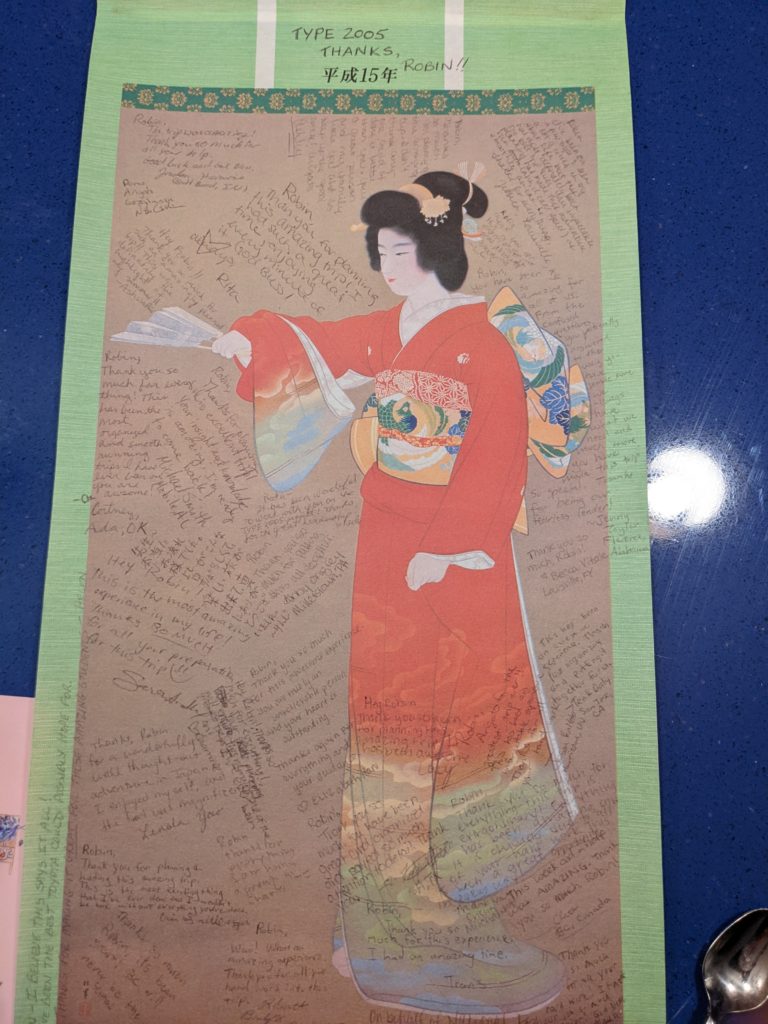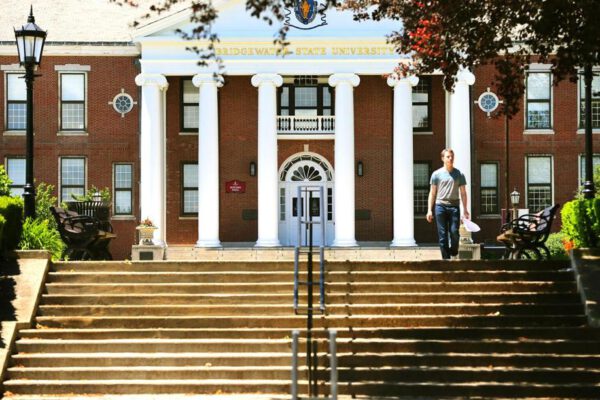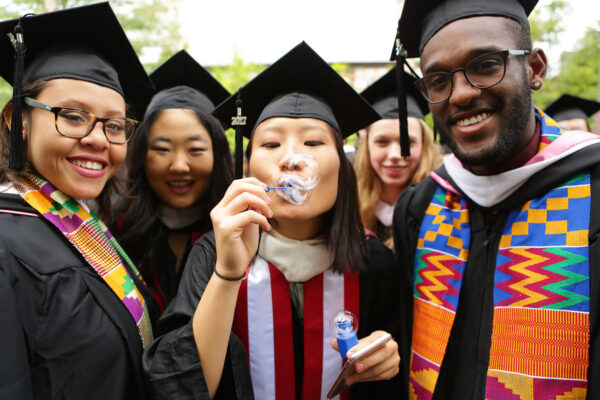January 25, 2022 update
Last Call to Tell Us About Internationalization on Your Campus
By Robin Matross Helms
We’re just about to the end of data collection for the Mapping Internationalization survey, and we need your help for one last push. Don’t worry—our “ask” is at the bottom of the post, and you’re welcome to scroll right there if you’d like.
But maybe instead, slow your scroll for a few moments to take a look at a different kind of scroll—a literal one, made of paper—and its connection to the ACE Mapping Internationalization on U.S. Campuses study. Over the years, I have come to refer to this particular scroll as the “Scroll of Awesomeness.”
In 2005, I took a group of high school students to the World’s Fair in Nagoya, Japan, for the Toyota Youth Program at Expo 2005 (TYPE) program. With an eye toward community relations and workforce development, participants were selected at high school science fairs in states where Toyota has a plant in the United States.
A large proportion of these students didn’t have passports prior to this trip. At least one had never been on an airplane. As an international educator, it was an honor to help shape their first global experience.
Throughout our 10 ten days together, I watched many “ah-ha” moments transpire. Connecting with local students; creatively figuring out how to communicate despite language differences; developing an appreciation for a new culture and its customs; navigating uncertainty and new situations; and building confidence, flexibility, and resilience. All of the outcomes—large and small—that we hope for in an international education experience.
On the last night of the program, the students presented me with a Japanese scroll. Nothing fancy, but thoughtfully procured by the group as a parting gift. The awesome part? They all signed it with heartfelt thanks and notes of appreciation. Many noted the program’s impact on them, all that they had learned, and how it set the stage for future global experiences. In short, I knew right then that the program had made a difference.

Now, back to Mapping. At its heart, internationalization—the topic of this survey—is really about the student experience. It’s about creating space and opportunities for global learning for all of our students and engendering thousands of the ah-ha moments that I saw during the TYPE Program, whether through study abroad, virtual exchange, course content, or co-curricular activities.
Though it’s a different kind of impact than watching a student’s eyes light up when a cultural realization hits, I’ve seen the impact of the Mapping study in driving institutional strategy and planning in our Internationalization Laboratory program and in helping colleges and universities articulate their commitment to global learning.
We’re just about at the end of the Mapping journey for this round, at least the data collection phase. It hasn’t been easy, and the pandemic has not helped. But at moments like this, at turning points, and perhaps when I need a little inspiration, I pull out the Scroll of Awesomeness as a reminder: This work matters. It’s worth it.
So now the request: LAST CALL. Please help us maximize the impact of this work by checking if your institution has completed the survey. If not, we’ll send it to you. Together we can get this done—and if you need inspiration, I’m happy to share my scroll.
October 27, 2021 update
By Maria Claudia Soler and Ben Cecil
What should legislators working on visa policy know about barriers to attracting international students and scholars to the United States? How has COVID-19 impacted the internationalization priorities for U.S. institutions? These are some of the questions that we have been asked when discussing our Mapping Internationalization on U.S. Campuses survey.
Many stakeholders wonder what the upcoming survey results will reveal about the future of internationalization and how the results will influence policy, particularly as the Biden administration and Congress continue to work on a number of issues touching higher education.
What do we already know about the current state of internationalization in higher education that might indicate some of what we will learn from the Mapping survey?
First, international student enrollments fell by 1.8 percent between the 2018-19 and 2019-20 academic years, likely due to the reduced mobility prompted by the pandemic.
Second, we are aware that COVID-19 has changed the landscape of internationalization beyond enrollment numbers. Last November, we surveyed college and university presidents on a variety of internationalization topics. When asked whether the COVID-19 pandemic would affect their institutions’ long-term strategy related to internationalization (beyond the 2020-21 academic year), 66 percent of the respondents answered yes. We also asked about their institution’s internationalization priorities beyond the 2020–21 academic year, and more than half of the respondents indicated that “recruiting international students” would be at the top. This was followed by “partnerships with institutions/organizations abroad” (41 percent) and “increasing education abroad for U.S. students” (29 percent).
Higher education has changed rapidly since we asked those questions last fall. We now wonder: what might institutions be doing differently? What will the new Mapping survey teach us about the future of internationalization in higher education?
As we journey to the final stages of data collection, it is critical that we include as many voices as possible. We have already heard from provosts, senior international officers, institutional researchers, and college and university presidents representing 623 institutions.
But we are not stopping here. Each survey response and voice matters—please join us on our journey to 1,000 responses if you have not already.
June 28, 2021 update
By Maria Claudia Soler
Developments in U.S.-foreign relationships impact internationalization in higher education in many ways, and the recent U.S. Innovation and Competition Act is no exception. As ACE’s Sara Spreitzer and Robin Helms discuss in the video below, the legislation has provisions on research security, intellectual property, and gift reporting, among other things, that impact American colleges and universities, especially their relationships with China.
According to Spreitzer, the main challenge of the legislation is to find a balance between increasing research security while encouraging international students and international partnerships. Chinese students comprise 35 percent of the international student population at American colleges and universities. Results from our 2016 Mapping Internationalization on U.S. Campuses survey showed that China was indeed one of the top target countries for international student recruitment and international partnerships, followed by India, and Vietnam. China also ranked as one of the top countries for international partnerships at colleges and universities—both for existing partnerships and as a target for expanded activity.
Given the recent developments with the U.S. Innovation and Competition Act, we hope the 2021 Mapping survey reveals information about all types of internationalization activities involving China and other countries. We launched Mapping in early March and so far, we have received 280 completed surveys (thank you again to those who have submitted them!) But we are still looking forward to hearing from at least 1,000 institutions, so please click here if you want to find out how your institution can participate.
May 21, 2021
By Robin M. Helms
The Chinese proverb that “a journey of 1,000 miles begins with a single step” has been a recurring theme in my career in international education. Even before I had heard the proverb itself, it would have been applicable to my life—the day in fifth grade when I walked into my first French class and discovered a love of language learning, after college when I got on the plane to teach English in China for the next year, and later when I interviewed for my first job with a study abroad provider. And while we certainly didn’t know it at the time, the day in March 2020 when I walked out of my office at One Dupont Circle was the start of a pandemic journey that at the moment is feeling like a lot more than 1,000 miles.
The step that started my nine-years-and-counting journey at ACE was when I was handed the data tables from the 2011 Mapping Internationalization on U.S. Campuses Survey to review, analyze, and write up as a narrative on my first day. It was both exciting and intimidating—this would be third iteration of the study, which was already unique and well known in the field of international education, and a basis for additional research.
Today, the study remains the only comprehensive sources of data on U.S. higher education internationalization. With its 30,000-foot view of the internationalization landscape, it has been a jumping-off point for countless other studies, dissertations, and class discussions. The creativity, additional insights, new interpretations, and in-depth research catalyzed by the Mapping survey continue to enrich the field and inform our practice.
Five years ago, the 2016 Mapping survey garnered our highest response rate ever—40 percent, somewhat remarkable in a time of survey fatigue and decreasing survey response rates overall. It was an intense yearlong journey that involved not only constant communication and efforts to get the word out however we could, but also what sometimes felt a bit like badgering potential respondents. But we got there. And with enhancements to the report and an online tool institutions can use to compare their data to peers, Mapping’s reach has continued to expand.
Now it is 2021, and the fifth iteration of the Mapping survey is underway. What a wild ride the past five years have been for international education, on so many fronts. In some ways, the Mapping survey could not be better timed to capture all that has transpired.
On the other hand, we had a dilemma—so many of the survey responses would be different for the year of the pandemic than for the preceding four years. How would we maintain our longitudinal consistency, but also separate out and document pandemic impacts? We came up with some creative solutions—you can learn about them in this video—and all told, we are proud of the survey and excited about our approach.
And now we need your help. We launched the survey in March, sending it to provosts. Next we’ll send it to senior international officers, then institutional researchers, and finally presidents. Our research team is hard at work updating our contact lists. We have a well-designed distribution plan and carefully timed survey reminders. But we need colleges and universities to complete the survey. All degree-granting U.S. institutions are eligible—and we need data from everyone, whether or not your institution is active in terms of international activity.
I won’t sugarcoat it: it’s pretty brutal out there when it comes to survey response rates. So far we have 215 completed Mapping surveys in (Thank you to those who have submitted them!). In 2016, we ultimately received 1,164 survey responses—understanding pandemic pressures and all the other variables at play, I’m hoping for 1,000 this time around. Triple digits was a milestone, but we have a long way to go.
Our journey to 1,000 surveys depends on your contributions. We are happy to work with you to get the survey to the right person on your campus, either electronically or in hard copy. In turn, we are committed to continuing to provide up-to-date data and information to the field.
We’ve started this blog post to keep you informed on our progress and to offer reflections on previous data and what we expect we might see in the 2021 iteration. And we’re going to be honest about where we are and the ups and downs of data collection.
What the Chinese proverb doesn’t say is that a journey of 1,000 miles is rarely completed alone. It’s all about your traveling companions and who you meet and connect with along the way. We hope you’ll join us in the 2021 Mapping Internationalization on U.S. Campuses journey!
If you have any questions or comments about this blog post, please contact us.


